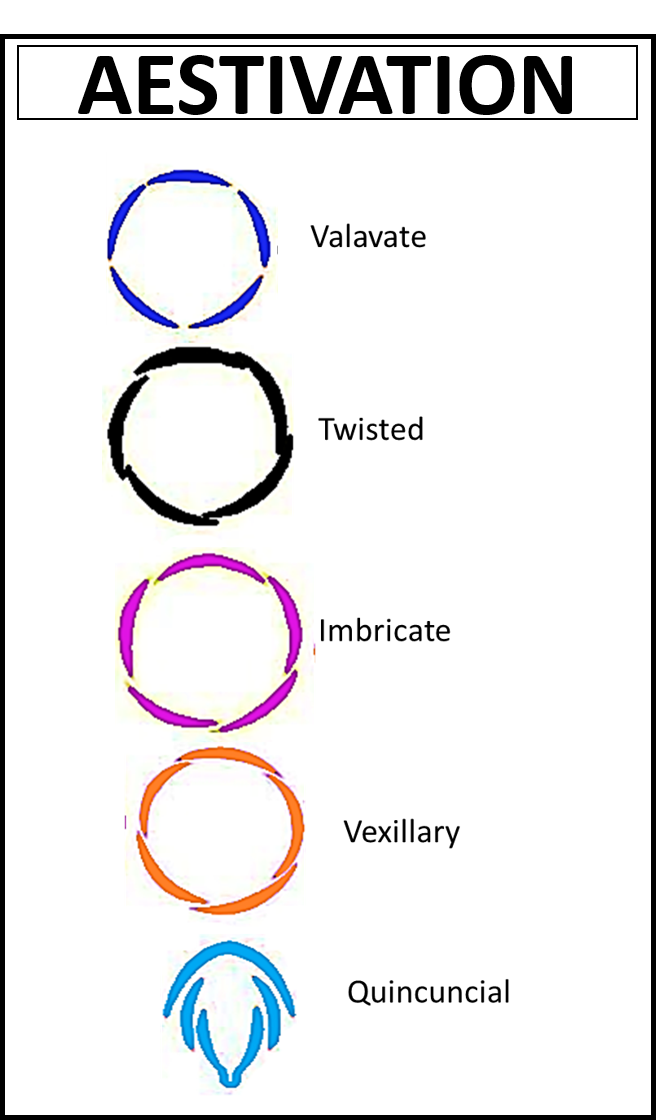
What is quincuncial aestivation?
Answer
412.2k+ views
Hint: It is the arrangement of the flower which consists of five floral parts. Here the two petals or sepals are arranged internally while the other two petals or sepals are arranged externally while the fifth part is arranged at the margin.
Complete answer:
Aestivation is the arrangement of sepals and petals of a flower when they are in bud condition.
Aestivation is of the following types- Valvate aestivation, imbricate aestivation, twisted aestivation, and
Quincuncial aestivation.
The floral leaves in the case of Quincuncial aestivation are arranged spirally. In this leaves 1 and 2 are external, 3 are partially external,4 and 5 are internal. It is commonly observed in the case of Guava.
Valvate aestivation - it is an arrangement in which the sepals and petals do not overlap each other in a flower bud and joins at their edges. China rose is an example of valvate aestivation.
Imbricate aestivation- When the sepals and petals are arranged in such a way that they are internal and overlap on both the margins. In this arrangement, one of the sepal or petal is external and overlaps with each other. Gulmohar is an example of the Imbricate aestivation.
Vexillary aestivation- it is an arrangement in which smaller petals are covered by one larger petal. The vexillum is the larger petal while the wings are the two curved petals. Vexillary aestivation is mainly seen in polypetalous. So, the correct answer is, "Quincuncial".
Note:
Position, arrangement, and overlapping of floral perianth parts are called perianth aestivation.
When the free perianth are found that are not attached to one another, then the condition is called polyphyllous.
Aestivation is also referred to as prefoliation.
Aestivation is an important factor for the classification of the plants.

Complete answer:
Aestivation is the arrangement of sepals and petals of a flower when they are in bud condition.
Aestivation is of the following types- Valvate aestivation, imbricate aestivation, twisted aestivation, and
Quincuncial aestivation.
The floral leaves in the case of Quincuncial aestivation are arranged spirally. In this leaves 1 and 2 are external, 3 are partially external,4 and 5 are internal. It is commonly observed in the case of Guava.
Valvate aestivation - it is an arrangement in which the sepals and petals do not overlap each other in a flower bud and joins at their edges. China rose is an example of valvate aestivation.
Imbricate aestivation- When the sepals and petals are arranged in such a way that they are internal and overlap on both the margins. In this arrangement, one of the sepal or petal is external and overlaps with each other. Gulmohar is an example of the Imbricate aestivation.
Vexillary aestivation- it is an arrangement in which smaller petals are covered by one larger petal. The vexillum is the larger petal while the wings are the two curved petals. Vexillary aestivation is mainly seen in polypetalous. So, the correct answer is, "Quincuncial".
Note:
Position, arrangement, and overlapping of floral perianth parts are called perianth aestivation.
When the free perianth are found that are not attached to one another, then the condition is called polyphyllous.
Aestivation is also referred to as prefoliation.
Aestivation is an important factor for the classification of the plants.

Recently Updated Pages
Master Class 11 Accountancy: Engaging Questions & Answers for Success

Glucose when reduced with HI and red Phosphorus gives class 11 chemistry CBSE

The highest possible oxidation states of Uranium and class 11 chemistry CBSE

Find the value of x if the mode of the following data class 11 maths CBSE

Which of the following can be used in the Friedel Crafts class 11 chemistry CBSE

A sphere of mass 40 kg is attracted by a second sphere class 11 physics CBSE

Trending doubts
10 examples of friction in our daily life

One Metric ton is equal to kg A 10000 B 1000 C 100 class 11 physics CBSE

Difference Between Prokaryotic Cells and Eukaryotic Cells

State and prove Bernoullis theorem class 11 physics CBSE

What organs are located on the left side of your body class 11 biology CBSE

The combining capacity of an element is known as i class 11 chemistry CBSE




